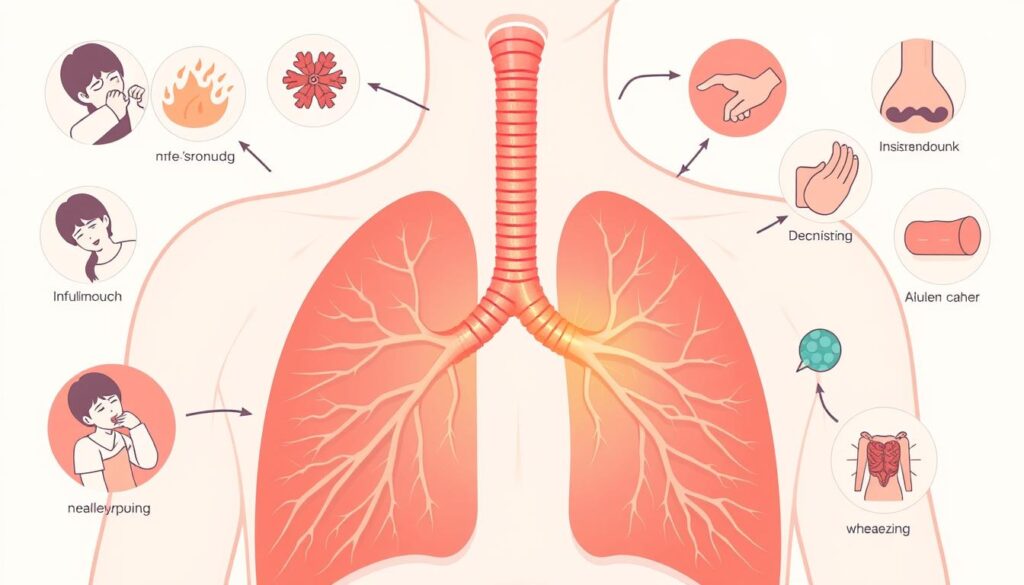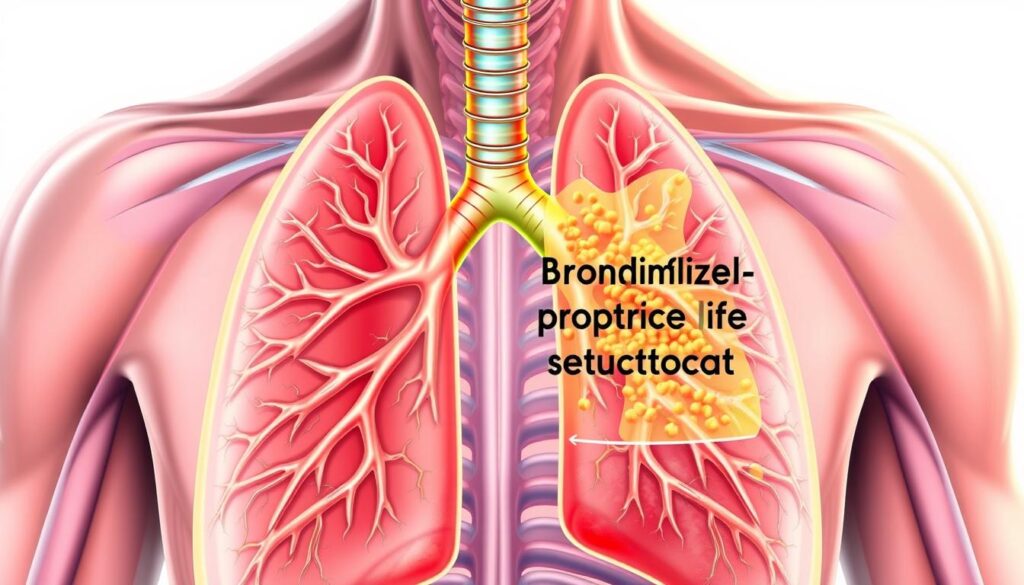This common respiratory illness affects millions, making their daily lives tough. It’s important to know the symptoms, causes, and treatments for acute bronchitis to manage it well.

Key Takeaways
- Acute bronchitis is a temporary inflammation of the bronchial tubes, often caused by viral or bacterial infections.
- Symptoms include persistent cough, chest discomfort, and difficulty breathing, which can last for several weeks.
- Common triggers include viral infections, environmental factors, and lifestyle habits like smoking.
- Diagnosis involves physical examination and, in some cases, diagnostic tests to rule out other respiratory conditions.
- Treatment typically focuses on managing symptoms, with medications and home remedies playing a crucial role in recovery.
Understanding Acute Bronchitis and Its Impact
Acute bronchitis is a condition where the bronchial tubes get inflamed. These tubes are the airways that connect the lungs to the trachea. This inflammation can cause a persistent cough, chest discomfort, and trouble breathing. It can really affect someone’s daily life and overall health.
What Happens During Bronchial Inflammation
When someone gets acute bronchitis, the bronchial tubes get irritated and swell up. This makes more mucus than usual. It’s harder for air to move in and out of the lungs, causing coughing, wheezing, and chest tightness.
Distinguishing Acute from Chronic Bronchitis
It’s key to tell the difference between acute and chronic bronchitis. Acute bronchitis is usually short-term and caused by a virus or bacteria. Chronic bronchitis, on the other hand, is long-term and often linked to smoking or environmental irritants.
Common Risk Factors
Some things can make you more likely to get acute bronchitis. These include:
- Smoking or being around secondhand smoke
- A weakened immune system from other health issues
- Having had a recent cold or flu
- Being exposed to air pollution or irritants
- Having chronic lung diseases like asthma or COPD
Knowing how acute bronchitis works and what makes it different is important. It helps manage the condition and reduce its impact on your health and life.
“Acute bronchitis is a common and often self-limiting condition, but it can have a significant impact on a person’s quality of life if not properly managed.”
Key Symptoms of Bronchial Infection
Acute bronchitis is a common respiratory issue. It shows clear signs of a bronchial infection. Knowing these symptoms is key to getting cough treatment and fixing breathing difficulties.
A persistent, annoying cough is a main sign of acute bronchitis. This cough might bring up mucus or phlegm, which can be clear, yellow, or green. You might also feel chest pain or a burning feeling as your bronchial tubes try to clear out the mucus.
Feeling tight or constricted in the chest is another common symptom. This can make breathing difficulties worse, especially when you’re active. People with acute bronchitis might also hear wheezing or a whistling sound when they breathe in and out. This shows that their airways are blocked.
- Persistent, irritating cough
- Mucus or phlegm production
- Chest discomfort or burning sensation
- Chest tightness and breathing difficulties
- Wheezing or whistling sounds during breathing
“Recognizing the key symptoms of acute bronchitis is the first step towards effective cough treatment and managing respiratory health.”
By paying attention to these symptoms, people can get the right medical help. This helps them feel better and get their breathing back to normal.
Common Causes of Acute Bronchitis
Acute bronchitis is a respiratory illness that blocks the bronchial tubes. It can be caused by many factors. Knowing what causes it helps in preventing and managing it.
Viral and Bacterial Triggers
Viruses and bacteria are the main causes of acute bronchitis. Viruses like influenza and RSV can make the bronchial tubes inflamed. Bacteria, including Streptococcus pneumoniae and Haemophilus influenzae, can also cause it.
Environmental Factors
Environmental irritants can also trigger acute bronchitis. Pollutants like cigarette smoke and air pollution can irritate the bronchial tubes. Changes in temperature and humidity can also lead to it.
Lifestyle Contributors
Certain lifestyle choices can increase the risk of acute bronchitis. Smoking weakens the respiratory system and makes infections more likely. Conditions like COPD or asthma also raise the risk.
| Cause | Description |
|---|---|
| Viral Infections | Influenza, respiratory syncytial virus (RSV), and other viruses can irritate the bronchial tubes, leading to acute bronchitis. |
| Bacterial Infections | Streptococcus pneumoniae, Haemophilus influenzae, and other bacteria can also contribute to the development of acute bronchitis. |
| Environmental Irritants | Exposure to pollutants, such as cigarette smoke, industrial chemicals, and air pollution, can trigger acute bronchitis episodes. |
| Lifestyle Factors | Smoking, both active and passive, as well as underlying medical conditions like COPD and asthma, can increase the risk of acute bronchitis. |
Understanding the causes of acute bronchitis helps in preventing and managing it. Recognizing the role of viruses, bacteria, environmental factors, and lifestyle choices is key. This knowledge is crucial for maintaining respiratory health and preventing acute bronchitis.
Diagnosing Bronchial Obstruction
Diagnosing acute bronchitis starts with a healthcare professional’s thorough examination. They first review the patient’s medical history. This includes any recent respiratory infections, exposure to irritants, or health conditions that may cause mucus buildup and chest discomfort.
The doctor listens to the patient’s breathing with a stethoscope. They look for wheezing, crackles, or other sounds that show bronchial inflammation. The doctor also checks for tenderness or sensitivity in the chest and back. This helps understand how severe the bronchial obstruction is.
At times, more tests are needed to confirm the diagnosis. These tests help rule out other respiratory conditions. They might include:
- Chest X-ray: To check for any abnormalities in the lungs or chest cavity
- Pulmonary function tests: To measure the patient’s breathing capacity and lung function
- Sputum culture: To identify any bacterial or viral infections that may be causing the bronchial inflammation
Through a detailed evaluation, the healthcare provider can make an accurate diagnosis. They then create a treatment plan that meets the patient’s specific needs.
| Diagnostic Procedure | Purpose |
|---|---|
| Medical History Review | To identify any underlying health conditions or recent exposures that may contribute to bronchial inflammation |
| Physical Examination | To assess the patient’s breathing patterns and detect any signs of bronchial obstruction |
| Chest X-ray | To rule out other respiratory conditions and confirm the presence of bronchial inflammation |
| Pulmonary Function Tests | To measure the patient’s lung function and breathing capacity |
| Sputum Culture | To identify any underlying viral or bacterial infections contributing to the bronchial inflammation |

“Accurate diagnosis is essential for effective treatment of acute bronchitis, as it helps healthcare providers develop a tailored approach to address the underlying causes and provide relief.”
Healthcare professionals use a detailed medical history, physical examination, and targeted tests to diagnose acute bronchitis. This approach helps them create an effective treatment plan for the patient’s specific needs.
Medical Treatment Options
Managing acute bronchitis requires a mix of medical treatments. These can help with cough, breathing issues, and other symptoms. Options range from prescription meds to over-the-counter solutions, offering relief and speeding up recovery.
Prescription Medications
For serious cases, doctors might suggest prescription meds. These include bronchodilators to open airways, corticosteroids to reduce swelling, and antibiotics for bacterial infections. Always take these as directed by your doctor.
Over-the-Counter Solutions
For mild cases, over-the-counter remedies are a good choice. Cough suppressants, expectorants, and decongestants can help with coughing, loosening mucus, and breathing. Always check labels and talk to a pharmacist or doctor before using these products.
When Antibiotics Are Necessary
Antibiotics are mainly for bacterial infections in bronchitis. Your doctor will decide if you need them. It’s important to finish the antibiotic course to avoid resistant bacteria.
Managing acute bronchitis often means using a mix of treatments and home care. Working with your healthcare team helps find the best way to tackle your symptoms and recover quickly.
| Prescription Medications | Over-the-Counter Solutions | When Antibiotics Are Necessary |
|---|---|---|
| Bronchodilators Corticosteroids Antibiotics (for bacterial infections) | Cough suppressants Expectorants Decongestants | Antibiotics are mainly for bacterial infections in bronchitis. Your doctor will decide if you need them. It’s important to finish the antibiotic course to avoid resistant bacteria. |
“It’s crucial to follow the prescribed course of antibiotics and complete the full treatment to prevent the development of antibiotic-resistant bacteria.”
Managing Breathing Difficulties at Home
Dealing with wheezing and respiratory illness from acute bronchitis can be tough. But, there are ways to ease your symptoms and help your body heal at home.
Enhance Airflow with Humidity
Adding moisture to your air can calm your airways and make breathing easier. Try using a humidifier or taking steamy showers to moisten the air.
Soothe Coughs with Hydration
Drink lots of fluids like warm herbal tea, water, or broth. They can thin out mucus and lessen coughing. Stay away from alcohol and caffeine, as they can dry you out.
Manage Discomfort with Over-the-Counter Remedies
Medicines like cough suppressants, expectorants, and decongestants can help with wheezing and respiratory illness. Just remember to take them as directed and talk to your doctor if your symptoms don’t get better.
Adopt Relaxation Techniques
Practicing relaxation, like deep breathing, can ease chest tightness and improve breathing. Yoga, meditation, or other stress-reducing activities can also aid in your recovery.
By using these simple home remedies, you can manage the discomfort of acute bronchitis. This will help you heal more comfortably.

Natural Remedies and Prevention Strategies
Medical treatments help manage acute bronchitis symptoms. But natural remedies and prevention can also aid in recovery. These approaches help with cough treatment and lung inflammation in a holistic way.
Effective Home Remedies
Several natural remedies can help during acute bronchitis. Here are some effective ones:
- Honey and lemon in warm water soothe the throat and ease coughing.
- Garlic has anti-inflammatory properties that reduce lung inflammation and improve breathing.
- Ginger tea thins mucus, reduces inflammation, and eases chest discomfort.
- Steam inhalation loosens mucus and relieves the respiratory system.
Preventive Measures
To avoid acute bronchitis, take these preventive steps:
- Get vaccinated against influenza and pneumococcal diseases to prevent respiratory infections.
- Practice good hygiene by washing hands, covering coughs, and avoiding sick people.
- Improve indoor air quality by using clean filters, air purifiers, and avoiding irritants.
Lifestyle Modifications
Changing your lifestyle can help prevent and manage acute bronchitis. Here are some tips:
| Lifestyle Factor | Benefit |
|---|---|
| Quit smoking | Reduces respiratory infections and promotes lung health |
| Stay physically active | Improves breathing and boosts immunity |
| Maintain a healthy diet | Supports the body’s healing processes |
By using natural remedies, preventive measures, and lifestyle changes, you can actively work towards recovery. This approach helps prevent future respiratory infections.
Recovery Timeline and Expectations
Recovering from a bronchial infection or respiratory illness takes time. Knowing the typical timeline helps set realistic expectations. Most people with acute bronchitis start feeling better in 7-10 days. The inflammation and cough start to go away.
But, the full healing process can take weeks to a month. This depends on how severe the infection is and individual factors.
During the initial recovery phase, you may still experience:
- Persistent cough that gradually improves over time
- Lingering chest discomfort or tightness as the airways heal
- Occasional wheezing or shortness of breath with physical activity
It’s important to be patient and let your body heal fully. Rushing back to normal activities too soon can prolong the healing process. It can even lead to a relapse of bronchial infection or respiratory illness symptoms.
Most healthcare providers suggest gradually increasing your activity level as tolerated. Still, get plenty of rest. Avoid strenuous exercise until the cough and other symptoms have largely subsided. With proper self-care and any necessary medical treatment, you can expect a full recovery. You should be back to your regular routine in 2-4 weeks.
“The key to a successful recovery is listening to your body and not pushing yourself too hard, too fast.”
When to Seek Medical Attention
Acute bronchitis can usually be treated at home. Rest, fluids, and over-the-counter remedies help a lot. But, some symptoms mean you need to see a doctor right away. It’s key to know these signs and get help fast to avoid serious problems.
If you notice any of these, call your doctor right away:
- Persistent or worsening breathing difficulties – If your cough gets worse and you have trouble breathing, see a doctor.
- High fever – A fever over 101°F (38.3°C) that lasts more than a few days might mean you have a bacterial infection.
- Difficulty swallowing – Painful swallowing or feeling like something is stuck in your throat could be a sign of a serious problem.
- Persistent chest pain – Chest discomfort that doesn’t get better with rest or over-the-counter pain meds might be a sign of a serious respiratory issue.
- Coughing up blood-tinged mucus – This could be a sign of a serious condition and needs a doctor’s check-up.
If you see any of these symptoms, don’t wait to call your doctor. Getting help quickly can stop things from getting worse and help you get better faster.
“Early recognition and treatment of acute bronchitis can help prevent the condition from escalating into a more serious respiratory illness.”
Conclusion
In this detailed article, we’ve looked into acute bronchitis, a common illness that affects many. We’ve covered the causes, from viruses and bacteria to environmental and lifestyle factors. This helps us understand the complexities of this condition.
We’ve also talked about the symptoms of bronchitis, like coughing, wheezing, and chest pain. Knowing these signs helps people get the right medical care when needed. The article also discussed how to diagnose and treat bronchitis, with options from prescription meds to natural remedies.
As we wrap up, it’s important to take care of our respiratory health. By following preventive steps, like good hygiene and avoiding irritants, we can lower the risk of bronchitis. Making healthy lifestyle choices also boosts our respiratory health.
FAQ
Q: What is acute bronchitis?
A: Acute bronchitis is a common illness that affects the airways. It causes inflammation and leads to a persistent cough. Other symptoms include mucus production and breathing difficulties.
Q: How does acute bronchitis differ from chronic bronchitis?
A: Acute bronchitis is short-term and usually goes away in a few weeks. Chronic bronchitis, however, lasts longer and can be more severe. It often involves persistent symptoms.
Q: What are the common symptoms of acute bronchitis?
A: Symptoms of acute bronchitis include a persistent cough and mucus production. You might also feel chest discomfort, wheezing, and have trouble breathing. These symptoms can last for weeks.
Q: What causes acute bronchitis?
A: Viral or bacterial infections are the main causes of acute bronchitis. Exposure to air pollution and smoking can also contribute. These factors lead to inflammation and blockage of the airways.
Q: How is acute bronchitis diagnosed?
A: Doctors diagnose acute bronchitis through a physical exam and medical history review. They might also do lung function tests or chest X-rays. This helps confirm the presence of bronchial obstruction and mucus buildup.
Q: What are the treatment options for acute bronchitis?
A: Treatment for acute bronchitis includes prescription medications and over-the-counter remedies. Bronchodilators or cough suppressants can help. Antibiotics may be needed if a bacterial infection is present. Always follow your doctor’s advice for treatment.
Q: How can acute bronchitis be managed at home?
A: To manage acute bronchitis at home, stay hydrated and use a humidifier. Get plenty of rest and consider over-the-counter cough medications or lozenges. Avoid irritants and practice good respiratory hygiene to help symptoms.
Q: When should someone seek medical attention for acute bronchitis?
A: Seek medical attention if symptoms last more than a week or get worse. Also, if you have severe chest pain, high fever, or trouble breathing. These could be signs of a serious condition that needs immediate medical care.
